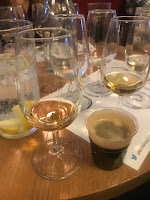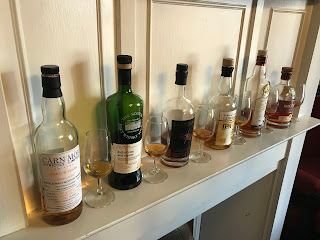 |
| The November line-up. |
 |
| G&M Macduff 18yo |
This was an 18yo from the Macduff distillery. On the Moray Firth coast, the distillery's official bottlings appear under the name Glen Deveron, named for the local river, so expressions under the Macduff name are the preserve of indies only.
On this occasion we were drinking a 58% whisky that was big and strong straight away. We got pear drops and vanilla, and one of the tasting notes which struck a particular chord was grapefruit. Some drinkers thought this started off well but perhaps didn't quite live up it, with the alcohol coming through a bit much. It was £100 but is now sold out.
 |
| 27yo Bunnahabhain |
This went down a storm. Very smooth, with a definite hint of butter - like melting butter on a crumpet as someone put it. There was definitely some citrus around too. A bottle will set you back £230 though! So although a lovely drop, perhaps not quite worth the price tag. It's a very drinkable 48.4%.
Another distillery which relatively rarely appears under its own name is Glen Elgin, and that's where he went for the third dram of the evening.
 |
| 22yo Glen Elgin |
We were told the distillery is noted for producing particularly fruity drinks, in part because of a long fermentation process. And this was certainly fruity, with a waxiness about it too.
Certainly a good drink but trying to follow those opening two drams, which had both been particularly punchy, was always going to be hard. So it maybe wasn't surprising this divided the room a little more. It's 49.5% and comes in at £107.
After a half-time break and a chance to refill our pint glasses downstairs at the Briton's, it was back for the next three whiskies, and we went west to Ben Nevis.
 |
| 21yo Ben Nevis |
By the time we'd got our heads around the logic of that, this particular dram was already in our past. We felt that while the bottle looked as snazzy as the concept, the contents possibly didn't quite live up to that promise.
But then again, after a couple of memorable, flavourful whiskies to start the evening, anything coming along later was maybe inevitably on a bit of a hiding to nothing. At £130, we weren't reaching for our phones to order any bottles, although they seem to have sold out anyway.
 |
| 14yo Hunter Laing Glenrothes |
This proved very popular with the membership, although with many having a known taste for big sherried whiskies this wasn't much of a surprise!
A couple of the tasting notes from the drinkers in the room were maple syrup and chocolate which probably says it all. It's 49.8% and at £73 or thereabouts doesn't represent the worst value in the world, especially if your Christmas list is looking a little bare.
 |
| 12yo Ledaig |
Another sherry cask one here, but much more of a peat king. By this stage of the evening my notes had become predictably short, and all I managed to get down was "we loved it". It's 58.4% and was £80 but has already all gone, sadly.
The voting for dram of the night came down to a straight fight between the Bunnahabhain and the Ledaig, with the Bunna taking it by 12 votes to 11, with three other whiskies getting two votes each.
Thank you to everyone old and new who attended another extremely busy tasting, as well as to the Britons for hosting us and in particular to Anna, Martin and Adam for coming back from the show which such an interesting and excellent range of drinks for us to try. Up next: it's the Christmas party!
 |
| Here they all are. |
















































